Pythons in Florida Everglades
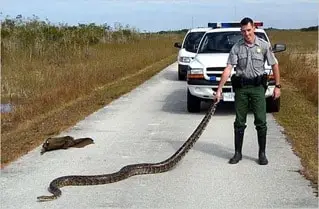
September 6, 2009
By Stuart Pimm
Special Contributor to National Geographic Voices
Pythons have invaded the Everglades, where they flourish in warm, wet habitat that has an abundant buffet of native species to feast on.
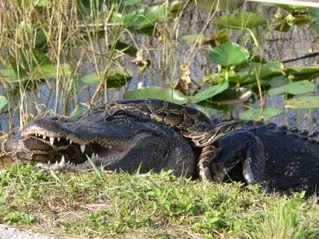
The giant snakes were imported to North America as pets, but released or escaped into Florida’s wetlands they are proliferating, challenging alligators for the top of the food chain, and potentially positioning themselves to invade much more of the United States.
Conservation biologist Stuart Pimm has dedicated his life to protecting species–but an infestation of 16-foot alien snakes in Florida’s iconic Everglades National Park has got him wondering how to eradicate this one. He is worried about the impact on indigenous species–and what could happen if pet owners release other big reptiles into the watery wilderness.
Everglades National Park, Florida
Most April mornings for the last 15 years have started well before dawn, with a cup of coffee and the drive into Everglades National Park. We’re in the helicopter while the sun is still below the horizon. No brilliant conversation at this hour.
Through my headset I hear, “Seven eight four, one six three bravo hotel.” A women’s voice echoes, “seven eight four, one six three bravo hotel.” Our pilot replies, “heading west from the Beard Center to 80 46 30, 25, 41 15, four souls on board, two and half hours of fuel.” The women’s voice repeats the numbers.
“Roger that, thank you,” and the conversation ends. There is no chit chat. We let the Park know where we’re going just in case the helicopter breaks down–which happens, but not often.
The sun is still not up and the colors are muted. The stands of pine trees are dark green, the prairies are dark buff. There’s a mist over them, gray in this light, but thin, translucent, rumpled by the most gentle breeze. Anything stronger would destroy the veil. It’s thin enough, sometimes, that I will stand with my head above it when we land.
The helicopter leaves and I listen in complete solitude. There’s a faint “bzzzz” to the north, so I check “one” on my clipboard. The Cape Sable sparrow– one of the rarest birds in North America and one found only in the Florida Everglades, is at home.
I know what you want to ask. Alone–and a very long, tough walk from the nearest road–what happens if I run into an alligator (there are lots of them), or a cottonmouth (you smell them first), or a Burmese python? A Burmese python?
The alligator and cottonmouth belong in the Everglades, but I really don’t relish the prospect of meeting a 4-meter (13-foot) constrictor, curled up on her eggs, as I wait for the helicopter to return to pick me up. I’m just not a snake person. And the pythons do not belong there.

There are snake people, of course. And the problem is that there are people who thought they were snake people, but grew out of it. Well, the snake grew them out of it, more correctly.

One of the Ten Largest Snakes in the World
The Burmese python grows to be one of the ten largest snakes in the world. Without doubt, it’s a beautiful animal. And a very popular pet. Type the name into Google and you immediately get advice on how to care for one.
It also comes with a warning too few people heed: They can grow to more than 5 meters long (16 feet) and weigh more than 80 kilos (200 pounds). And you have to feed them. And they get very large very quickly.
What starts out as a cute, mouse-eating novelty, can become a liability in a couple of years.
I talked to Dr. Nicolette Cagle, a Duke University colleague who did her Ph. D on snakes. Her husband, Mark–a vet–was an essential part of the conversation: It took both of them to hold Boa, their pet boa, as can be seen in the photo below.
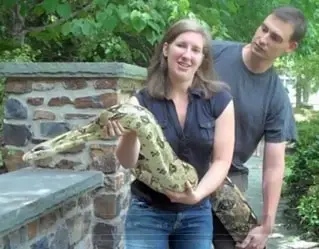
Boas are snakes related to pythons and, like pythons, grow quickly to a large size. “They’re fascinating creatures,” Nicolette told me, “so many people are afraid of them–but there’s no reason to be.
For the most part, they’re even-tempered–we like to show her to school groups.”
Nicolette and Mark have had Boa since she was just over a meter (four feet) long. But handling such a large snake requires dedication.
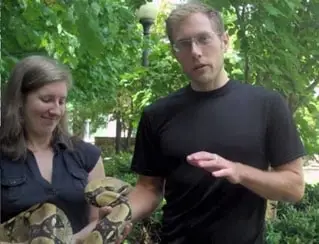
So, what to do if you are unable to manage such a large reptile?
If you live in South Florida, the temptation often proves irresistible–you let your pet go.
Many people have done this, even though this is against the law and there are humane alternatives. The result is that today the Everglades is home to perhaps thousands of Burmese pythons. And they’re breeding.
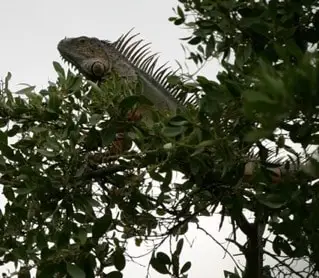
It’s not just pythons that are immigrants in the Everglades. The waters of this unique freshwater marsh have been populated by a veritable United Nations of tropical fish species. They too were dumped by owners who tired of them.
There are green iguanas across southern Florida, too–and the list of alien species that have taken up residence in the Sunshine State goes on.
The damage that such invasive species cause is huge and, in the Everglades, many native species could be at risk. Alien species of all kinds are eating native species, or their food. Pythons could be emerging as the Everglades’ alpha predator.
On the far side of the world, the brown treesnake was responsible for eating all of Guam’s birds to extinction in the wild. That’s what can happen when an alien predator is introduced into a habitat where it has no natural enemies. (You can read more about the Guam situation on the USGS Web site.)
Python hunters have been recruited to go after the snakes in Florida. But even with the help of snake-sniffing dogs, the bag has not been impressive thus far.
What I do for a living is to understand why species go extinct– and what we can do to prevent extinction. In this case, we want to know how to make Burmese pythons extinct in the U.S. wilderness, somewhere they do not belong.
So what are this species’ vulnerabilities?
I talked to Dr. Lucas Joppa, another Duke University snake expert. “These pythons have an amazing advantage in the Everglades,” he told me. “They are superb predators on the land–and they are superb predators in water, too.”
A weakness, however, may be the python’s need for warm places to lay its eggs. After giving birth, female snakes remain with their eggs for over a month to keep them warm,” Joppa added.
Joppa thinks one way to control pythons in the Everglades may be to provide them with a kind of battery, or solar-powered electric blanket. “Create somewhere nice and warm to lay eggs and that’s where mother python will be in the breeding season.”
Ironically, pythons are threatened with extinction in the wild, Joppa noted. “They’re hunted for their skins and for their meat.”
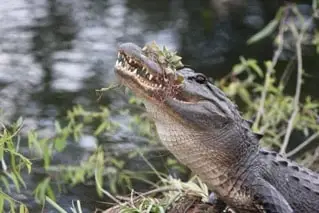
Hiss-kabobs
Even if python stir-fry, or my personal suggestion, hiss-kabobs, might not catch on, the skins could create interesting incentives for python hunting.
Perversely, because the snake is listed by CITES — the Convention on International Trade in Endangered Species — trading python skins internationally is illegal.
Burmese pythons top the list of reptiles for sale by pet dealers, but they are not the only species on the list.
Boas are a popular pet and have the same size issues as pythons. Are they and other big snakes also headed for the Everglades?
I worry that the worst is to come.
